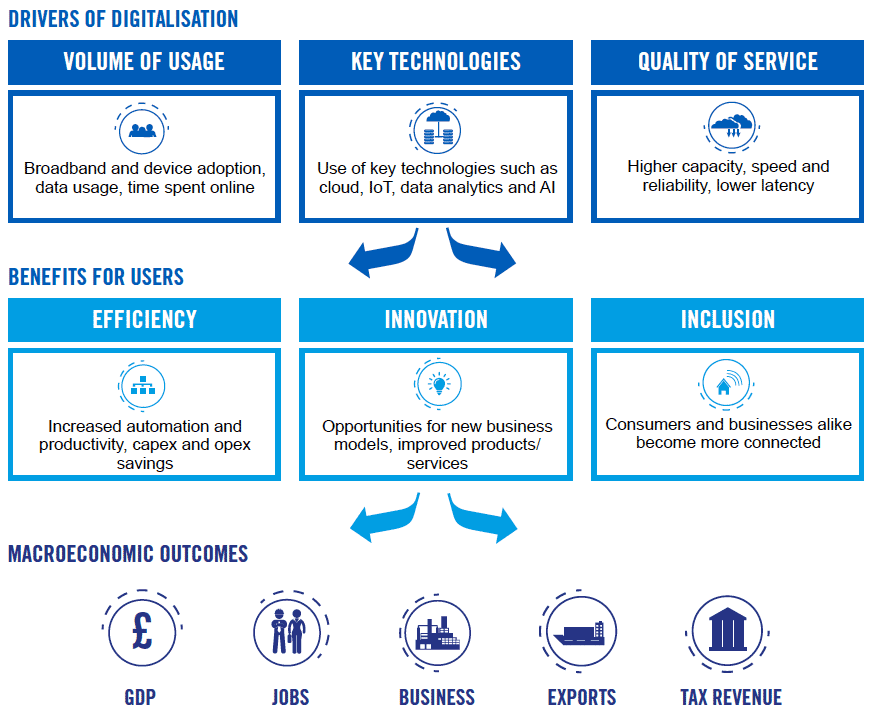5G: strategy for Scotland
A strategy outlining our vision for 5G and our commitment to embracing the opportunities it will give to build towards our aspiration to establish Scotland as a forward looking digital nation.
Annex A: Economic impact analysis
The Scottish Futures Trust, on behalf of the Scottish Government, commissioned Deloitte to undertake an assessment of the potential economic impact of enhanced digital capability in Scotland relating to wireless and mobile technologies such as 4G and 5G. This report: Scotland's Digital Potential with Enhanced 4G and 5G Capability[28]; being published alongside this strategy, provides estimates of the economic impact for Scotland under different future scenarios. To support the analysis and build upon existing understanding, potential 5G use cases are identified in areas that could strengthen Scotland's competitiveness and contribute to current areas of innovation.
Several scenarios have been used to demonstrate the breadth of the potential impact to the economy, to society, to communities and to remote and rural communities. A transformative scenario looks ahead to 2035 and focuses on the role of wireless capability within a wider digital ecosystem. As such, it captures improved outcomes in areas that support the potential of wireless connectivity, such as fixed broadband connectivity, IoT, cloud computing and data analytics.
Figure 4
Infographic:

Infographic text:
Drivers of Digitalisation
Volume of Usage: Broadband and device adoption, data usage, time spent online
Key Technologies: Use of key technologies such as cloud, IoT, data analytics and AI
Quality of Service: Higher capacity, speed and reliability, lower latency
Benefits for Users
Efficiency: Increased automation and productivity, capex and opex savings
Innovation: Opportunities for new business models, improved products/services
Inclusion: Consumers and businesses alike become more connected
Macroeconomic Outcomes
GDP
Jobs
Business
Exports
Tax Revenue
This transformative scenario models a world in which pervasive, high-performance 5G connectivity is at the heart of a rapid acceleration in digital transformation. Flexible and reliable networks will enable a plethora of innovative use cases. In this scenario, the so-called digital divide, between the haves and have-nots, is reduced to a minimum and businesses are able to leverage new technologies to generate efficiencies and revenue growth.
This scenario shows incrementally improved outcomes compared with a base case scenario which represents how Scotland might evolve if there is an absence of any actions to improve 4G and 5G capabilities. The estimated economic impact associated with this transformative scenario is based on the framework summarised in figure 4.
The Deloitte report's[29] key findings are summarised as follows:
GDP impacts
- Scotland could add £17 billion to GDP by 2035 which would represent a return to Scotland's historical long-run trend growth rate of 2%, from the GDP growth rate of 1.5% otherwise assumed in the base case.
- In absolute terms, the GDP impacts are far larger in urban and semi-urban areas than in the rest of Scotland but are proportionately larger for rural and remote rural areas of Scotland.
- However, this simply reflects that urban and semi-urban areas account for the largest proportion of economic output.
- In fact, it is rural and remote areas that see the largest proportionate impact in the most positive scenarios, as enhancements in 4G and 5G capability narrow the digital divide by allowing consumers and businesses to access services regardless of the location. It will allow citizens in remote areas to remain economically active, maximising opportunities for remote and flexible working, preventing rural depopulation.
- The estimated GDP impacts are the product of two factors: higher employment due to increased economic activity and higher labour productivity due to more efficient ways of working.
- Around 160,000 net new jobs would be created by 2035 in the Scottish economy relative to the base case, representing an increase of around 6% compared to the projected level of employment in 2035.
- Productivity per worker is estimated to increase by a weighted average of £1,600 per year by 2035.
A More Digitalised Economy
- Enhanced wireless capability will lead to a more digitalised society, creating demand and opportunities for new business models, products and services across various sectors.
- This may reduce business start-up costs, increase the chances of scaling-up innovative enterprises, and stimulate exports, with the adoption of flexible working practices and cost-reducing technologies, such as cloud computing supported by enhanced 4G and 5G capability.
- Estimated increase in the creation of 3,100 new businesses and a £3.3 billion growth in export volumes, both of which are indicative of increased global competitiveness for Scotland.
- Transformative use cases could support a more inclusive and greener society:
- In addition to economic impacts, enhanced wireless capabilities could also generate positive social impacts.
- Greater levels of remote and flexible working could potentially enhance national levels of productivity, reducing travel and associate carbon emissions, delivering sustainable rural growth.
- In summary, new use cases can increase digital participation, leading to greater social inclusion and wider access to key services and opportunities, while specific use cases in sectors such as education, healthcare, transport and energy can enable the delivery of high-quality public services while minimising negative impacts on the environment.
Social Impacts
Inclusion
- Greater inclusion, equality and participation, including for vulnerable groups
- Wider access to more flexible employment
- Easier access to healthcare, education and online shopping
- New use cases in agriculture, aquaculture and tourism support rural communities
Environment
- Reduced consumption from smart heating and automation
- Automated processes reduce use of energy and resources
- Reduced emissions from smarter transport ecosystem
- Smart energy grids facilitate integration of renewables
- 5G enables higher energy efficiency
Digital Public Services
- Preventative healthcare with greater patient engagement
- Immersive and interactive educational content
- Efficient and reliable transport ecosystem with a high degree of multimodal integration
- Public safety enhanced by new uses of technology to respond in emergency or disaster situations
Contact
There is a problem
Thanks for your feedback